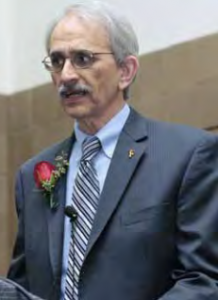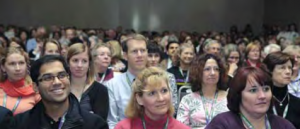
This lecture honors one of physical therapy’s best and brightest – Pauline ‘Polly’ Cerasoli (Feb 25, 1939 – Sept 11, 2010).
The Cerasoli lecture began with a tribute to Polly by a long-time friend and colleague Bette Ann Harris in which we learned more about the places she spent time:
- Northeastern University (1967-1981)
- Massachusettes General Hospital (1981-1987), doctorate in education
- University of Colorado Denver (1988-1996), director of physical therapy program
We also learned of the major contributions made by Polly to the physical therapy profession:
- Started the Boston Education Consortium in the 1970s
- Published a landmark paper titled ‘Research experience in an undergraduate physical therapy program’ – [pubmed link]
- First appointed clinical specialist at Massachusetts General Hospital in 1981
- Mentored a blind physical therapist in 1992
Next, APTA President Scott Ward asked for a moment of silence, as it was the first Cerasoli lecture since she passed away in Sept of 2010. Dr. Ward announced that the 2012 Cerasoli Lecture will be given by Christine Baker from UT Galveston.
Dr. Ward then introduced us to the 14th Cerasoli Lecturer – Dr. James Gordon. Dr. Gordon is associate dean and chair in the division of biokinesiology and physical therapy at USC.
Dr. Gordon’s talk was titled ‘Excellence in Academic Physical Therapy – What Is It and How Do We Get There?’ I’ll try my best to summarize the talk below.
We (physical therapists) must accept the challenge that lays before us – pursue excellence.
On January 15, 1921, that 30 PT aides formed the APTA at the Keene’s Chop House in NYC. Now, a century later, Vision 2020 is lies ahead. It is the challenge.
What is needed to meet this goal is a strong academic foundation. It is in the academic setting that the physical therapy profession does its thinking.
Dr. Gordon defined a strong academic foundation as having three pillars – Education, Research, and Clinical Practice. All three pillars need to be in place. A classic three legged stool analogy, the foundation will topple with the absence of just one of the three pillars.
Dr. Gordon stated that excellence today is the norm for tomorrow. Excellence is the engine of the train, accredidation is the caboose (crowd chuckles).
So what is the agenda to achieve excellence? It is fulfilling all three pillars of the academic foundation.
1. Education
The most urgent task is to standardize curricular competencies. There is “unwarranted variation in physical therapy practice”. For example, there is large variation in the prerequisites, and program length. An emphasis on preparing generalists is the problem. Accreditation offers a list but no priority. Curricular competency needs to be standardized. Students need to have the ability to treat a patient with a defined condition under a defined set of characteristics (settings, acuity, age).
2. Research
Not much to say here. All programs should be involved and the big should help the small.
3. Clinical Practice
All programs across the country need to be involved. Currently, only 22% of programs have any form of program sponsored practice. Practice is important because it enhances teaching and provides a venue for research.
Lastly, Dr. Gordon addressed the infrastructure requirements to achieve program growth. Of the 213 accredited physical therapy programs in 200 institutions, 206 offer a DPT degree. Currently, 75% of faculty are PhD-level prepared. Many of these programs are very small. 50% are in Universities with research institutions and 35% of physical therapy programs are in medical centers. The average class size is 42.5, and 20% of programs have class sizes less than 20.
Why emphasize program growth? Dr. Gordon argued that this will bring a greater breadth of knowledge, support more research, and meet the need for more physical therapy students.
Dr. Gordon then wrapped up with his two take-home points:
- A strong academic foundation is essential for achieving excellence in physical therapy
- A strong academic foundation is dependent on three pillars (Education, Research, Clinical Practice), and you need them all


I couldn’t agree more with the need for academic physical therapy programs to standardize content. The current standard, at least what documentation audits of my practice show, is that tests and measures haven’t changed in 20 years since I graduated!
How can that be? I have hired DPT therapists who are still using Manual Muscle Testing to assess musculoskeletal patients for chronic pain and disability.
I thought MMT was a tool developed 99 years ago primarily to measure the effect of polio. Surely better tests have been developed since then to describe the patient experience and predict the outcome of therapy?
The last is rhetorical because I know that better tests do exist – because I use them and I teach them.
The problem, as I see it, is the current focus on clinical documentation as a “narrative” – the therapist is telling the patient’s story.
This narrative focus discourages data driven decisions, encourages useless speculation and repetitive “drivel”.
Can educators standardize an approach to clinical documentation?
Can data-driven physical therapists’s decisions become the new standard?